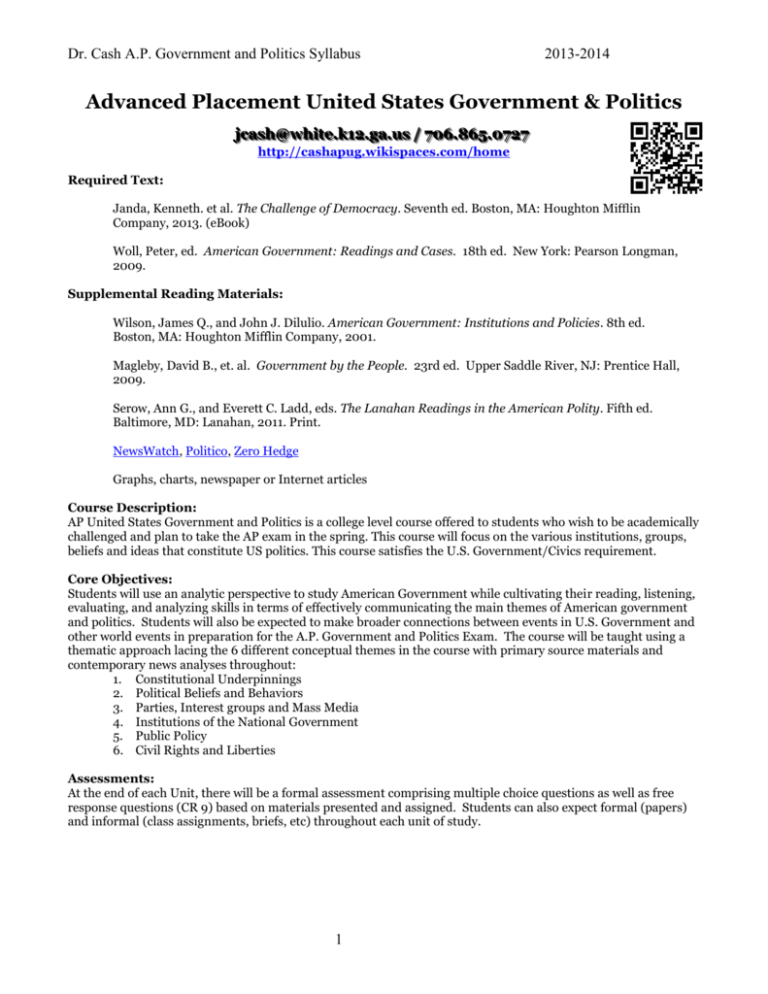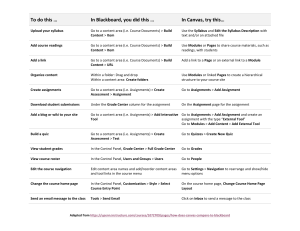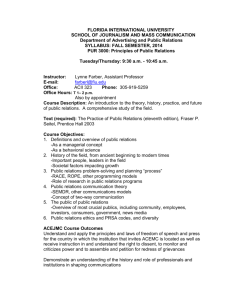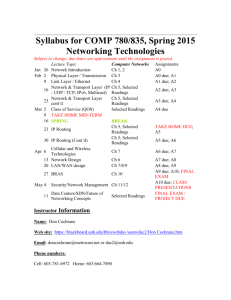
Dr. Cash A.P. Government and Politics Syllabus
2013-2014
Advanced Placement United States Government & Politics
jjccaassh
h@
@w
wh
hiittee..kk1122..ggaa..u
uss // 770
066..8
86655..0
0772277
http://cashapug.wikispaces.com/home
Required Text:
Janda, Kenneth. et al. The Challenge of Democracy. Seventh ed. Boston, MA: Houghton Mifflin
Company, 2013. (eBook)
Woll, Peter, ed. American Government: Readings and Cases. 18th ed. New York: Pearson Longman,
2009.
Supplemental Reading Materials:
Wilson, James Q., and John J. Dilulio. American Government: Institutions and Policies. 8th ed.
Boston, MA: Houghton Mifflin Company, 2001.
Magleby, David B., et. al. Government by the People. 23rd ed. Upper Saddle River, NJ: Prentice Hall,
2009.
Serow, Ann G., and Everett C. Ladd, eds. The Lanahan Readings in the American Polity. Fifth ed.
Baltimore, MD: Lanahan, 2011. Print.
NewsWatch, Politico, Zero Hedge
Graphs, charts, newspaper or Internet articles
Course Description:
AP United States Government and Politics is a college level course offered to students who wish to be academically
challenged and plan to take the AP exam in the spring. This course will focus on the various institutions, groups,
beliefs and ideas that constitute US politics. This course satisfies the U.S. Government/Civics requirement.
Core Objectives:
Students will use an analytic perspective to study American Government while cultivating their reading, listening,
evaluating, and analyzing skills in terms of effectively communicating the main themes of American government
and politics. Students will also be expected to make broader connections between events in U.S. Government and
other world events in preparation for the A.P. Government and Politics Exam. The course will be taught using a
thematic approach lacing the 6 different conceptual themes in the course with primary source materials and
contemporary news analyses throughout:
1. Constitutional Underpinnings
2. Political Beliefs and Behaviors
3. Parties, Interest groups and Mass Media
4. Institutions of the National Government
5. Public Policy
6. Civil Rights and Liberties
Assessments:
At the end of each Unit, there will be a formal assessment comprising multiple choice questions as well as free
response questions (CR 9) based on materials presented and assigned. Students can also expect formal (papers)
and informal (class assignments, briefs, etc) throughout each unit of study.
1
Dr. Cash A.P. Government and Politics Syllabus
2013-2014
Weeks 1-4
Unit 1: Constitutional Underpinnings of the U.S. Government (CR 1: 5-15% of
course/exam)
1.1 The State
1.2 Original Intent
1.3 Federalism
Students will develop an understanding of origin of democracy, natural rights of American colonists, origins of the
American Republic, Principles of the US Constitution, Separation of Powers, Limited Government, the Principle of
Judicial Review, origin and structure of Federalism. In this unit, students will address the underpinnings of the
Constitution. The six principles of government will direct the discussions on both historic and current issues. The
ideas of the Framers will be analyzed and ideas found within will be applied to current issues.
Janda Textbook Readings:
Chapter 1 – Freedom, Order, Or Equality?
Chapter 2 – Majoritarian or Pluralist Democracy?
Chapter 3 – The Constitution
Chapter 4 – Federalism
Supplemental Readings (CR 8):
Woll Reader:
Reading 1: John Locke, Second Treatise, Of Civil Government
Reading 4: James Madison, Federalist 47, 48, 51
Reading 6: Alexander Hamilton, Federalist 16, 17
Reading 8: James Madison, Federalist 44
Reading 9: James Madison, Federalist 45
Reading 10: James Madison, Federalist 39
Reading 12: McCulloch v. Maryland, 4 (1819)*
Reading 13: Gibbons v. Ogden (1824)*
Reading 31: Federalist 10!!!
Lanahan Reader:
Reading 21: Is Federalism the Reason for Policy Failure in Hurricane Katrina?
Magleby & Wilson excerpts
Primary Documents: (CR 8):
Machiavelli, The Prince
Hobbes, Leviathan
Montesquieu, Spirit of the Laws
Rousseau, The Social Contract
Archbishop Langton, The Magna Carta
Dickinson, The Articles of Confederation
Jefferson, Declaration of Independence
Madison, The US Constitution
US vs. Lopez (1995)*
Fletcher v Peck (1810)
US v Morrison (2000)
New Jersey v. T.L.O. (1983)
Dartmouth College v Woodward (1818)*
Safford Unified School District v Redding (2008)
Gila County Youth Detention Center (1966)
Kelo v. City of New London (2005)*
Interpretation of Data (CR 7):
A variety of charts, political maps, graphs, political cartoons, video clips, internet sites (such as PEW
Research Site), newspapers, pollster data and other media for analysis and interpretation
Unit exam consisting of multiple choice questions as well as free response questions based on all
readings and classroom discussions (CR 9)
2
Dr. Cash A.P. Government and Politics Syllabus
2013-2014
Weeks 5-9
Unit 2: Political Beliefs & Behaviors (CR 2: 10-20% of course/exam)
2.1 Political Culture
Students will analyzes beliefs that citizens hold about their government and its leaders, processes by which
citizens learn about politics, the nature, sources, and consequences of public opinion, the ways in which citizens
vote and otherwise participate in political life, and factors that influence citizens to differ from one another in
terms of political beliefs and behaviors. In this Unit, students will study sources of American’s political beliefs and
behaviors. Particular attention will be paid to the influence of family, peers, and the media. Multiple types of
political participation will be studied such as voting, protest, campaigning, and community activities. Students
will evaluate why people do or do not participate in government. Data will be analyzed in search of historical and
current trends in voting and other forms of political participation. Different demographics will be studied through
the use of maps and graphs.
Janda Textbook Readings:
Chapter 5 – Public Opinion and Political Socialization
Supplemental Readings (CR 8):
Lanahan Reader:
Reading 1: Democracy in America
Reading 5: Race Matters
Reading 57: Public Opinion & American Democracy
Wheelan, Charles. The Centrist Manifesto excerpts
Primary Documents (CR 8):
PEW Research Political Ideology
Palko v. Connecticut (1937)
Furman v. Georgia (1971)
Engel v. Vitale (1961)
Interpretation of Data (CR 7):
A variety of charts, political maps, graphs, political cartoons, video clips, internet sites (such as PEW
Research Site), newspapers, pollster data and other media for analysis and interpretation
http://people-press.org/reports/
http://pewresearch.org/pubs/1207/republican-party-identification-slips-nationwide-pennsylvaniaspecter-switch
Unit exam consisting of multiple choice questions as well as free response questions based on all
readings and classroom discussions (CR 9)
3
Dr. Cash A.P. Government and Politics Syllabus
2013-2014
Weeks 10-14
Unit 3 – Political Parties, Interest Groups, Mass Media & Elections (CR-3: 10-20%
of course/exam)
3.1 Interest Groups
3.2 Media
3.3 Political Parties
3.4 Elections
Students will research the strongest influences on public opinion and how Americans organize to express their
opinions. Historical and current opinions of political parties, interest groups, and the media will be analyzed.
Focus will be placed on the structure and history of these groups. Group activities will be used to emphasize the
need for compromise amongst groups.
Janda Textbook Readings:
Chapter 6 – The Media
Chapter 7 – Participation and Voting
Chapter 8 – Political Parties
Chapter 9 – Nominations, Elections, and Campaigns
Chapter 10 – Interest Groups
Supplemental Readings (CR 8):
Woll Reader:
Reading 35: Divided We Govern, Theory of Critical Elections
Reading 36: A Theory of Critical Elections
Reading 38: Reading 38. The Responsible Electorate
Reading 40: Buckley v Valeo (1967)*
Reading 41: Citizens United v Federal Election Commission, US Supreme Court (2010)
Reading 44: The Role of Interest Groups in Government
Lanahan Reader:
Reading 30: Hey There! SenJohnMcCain Is Using Twitter
Reading 70: How Barrack Obama Won
Reading 74: Is 2008 a Realigning Election? Numbers Offer Some Clues
Magleby & Wilson excerpts
Political Typology PEW Research Center
Primary Documents (CR 8):
New York Times Co. v. United States (1971)*
Shelley v. Kraemer (1947)
Interpretation of Data (CR 7):
A variety of charts, political maps, graphs, political cartoons, video clips, internet sites (such as PEW
Research Site), newspapers, pollster data and other media for analysis and interpretation
http://www.livingroomcandidate.org
Unit exam consisting of multiple choice questions as well as free response questions based on all
readings and classroom discussions (CR 9)
4
Dr. Cash A.P. Government and Politics Syllabus
2013-2014
Weeks 15-23
Unit Four – Institutions of National Government (CR 4: 35-45% of course/exam)
4.1 Congress
4.2 Executive
4.3 The Imperial Presidency
4.4 Judiciary
4.5 Bureaucracy
Students will compare and contrast Expressed and Implied powers of the three branches of government, evaluate
the influence and power of the bureaucracy, and analyze the relationships between the four organizations. In this
Unit, students will be exposed to the structure and workings of the three branches of government and the
bureaucracy. The importance of checks and balances and the separation of powers will be emphasized. Conflicts
between these institutions and other groups previously studied will be analyzed in historic and current contexts.
Students will address questions such as: How does the President deal with the media? How is Congress limited by
the Courts? How are states affected by federal decisions?
Janda Textbook Readings:
Chapter 11 – Congress
Chapter 12 – The Presidency
Chapter 13 - The Bureaucracy
Chapter 14 – The Courts
Supplemental Readings (CR 8):
Woll Reader:
Reading 46: Federalist 70
Reading 51: Ex Parte Milligan
Reading 52. Boumediene v. Bush, President of the US, US Supreme Court, 2008
Reading 55. James Madison, Federalist 53, 56, 57, 58, 62, 63
Reading 60: David R. Mayhew, Congress: The Electoral Connection
Reading 61: Richard F. Fenno, Jr., Home Style and Washington Career
Reading 64: Alexander Hamilton, Federalist 78
Reading 65: Marbury v. Madison, 1 Cranch 137 (1803)*
Reading 66: John P. Roche, Judicial Self-Restraint
Reading 70: The Obligation to Follow Precedent
Reading 71. In Re Slaughter-House Cases, 83 U.S. 36 (1873)
Lanahan Reader:
Reading 33: The Imperial President
Reading 36: The Rise of the Plebiscitary Presidency
Reading 42: Bureaucracy
Reading 46: Pursuit of Justices
Magleby & Wilson excerpts
NPR, Why We Love to Hate Congress
Balance of Power Between Congress and the President, Interconnections, Incorporation Doctrine, College
Board
iCivics
Primary Documents (CR 8):
Madison, Hamilton, Federalist No. 55, 68, & 70
Ex Parte McCardle (1868)
Term Limits v Thornton (1994)
Baker v Carr (1960)*
United States v Nixon (1974)*
INS v Chada (1981)*
United States v Curtis-Wright Export Crorp (1936)
Clinton v City of New York (1997)*
Swann v Charlotte-Mecklenburg Bd. Of Ed. (1970)
Korematsu v United States (1944)
Interpretation of Data (CR 7):
A variety of charts, political maps, graphs, political cartoons, video clips, internet sites (such as PEW
Research Site), newspapers, pollster data and other media for analysis and interpretation
Unit exam consisting of multiple choice questions as well as free response questions based on all
readings and classroom discussions (CR 9)
5
Dr. Cash A.P. Government and Politics Syllabus
2013-2014
Weeks 24-28
Unit 5 – Public Policy (CR 5: 5-15% of the course/exam)
5.1 Economic
5.2 Regulatory Policy
5.3 Domestic & Social Policy
5.4 Foreign Policy
Students will evaluate federal policymaking, the formation of policy agendas, the role of institutions in the
enactment of policy, the role of the bureaucracy and the courts in policy implementation, and interpretation
between policy processes and political institutions and federalism, political parties, interest groups, public
opinion, elections and policy networks. In this unit, students will examine the role of governmental institutions,
interests, and processes in the making of public policy. Students will also research how the interpretation of public
policy affects its implementation and survival. This unit will be used to demonstrate the full impact of institutions,
players, and principles in our federal government. Also, students will look at the state and local government’s role
in public policy making.
Janda Textbook Readings:
Chapter 17 – Policy Making
Chapter 18 – Economic Policy
Chapter 19 – Domestic Policy
Chapter 20 – Global Policy
Supplemental Readings (CR 8):
Woll Reader:
Reading 45: The Misplaced Obsession with PACs
Reading 54: The Rise of the Bureaucratic State
Lanahan Reader:
Reading 88: Bad Money
Magleby & Wilson excerpts
Webber, Max. Bureaucracy excerpts
Primary Documents (CR 8):
Medicare (A, B, D)
Defense of Marriage Act (2013)
Americans with Disabilities Act (1990)
Shelby County v. Holder (2013)
US v. Windsor (2013)
United States v. Calandra (1973)
Miranda v. Arizona (1965)*
Wolf v. Colorado (1948)
Interpretation of Data (CR 7):
A variety of charts, political maps, graphs, political cartoons, video clips, internet sites (such as PEW
Research Site), newspapers, pollster data and other media for analysis and interpretation
Poverty Line
Unit exam consisting of multiple choice questions as well as free response questions based on all
readings and classroom discussions (CR 9)
6
Dr. Cash A.P. Government and Politics Syllabus
2013-2014
Weeks 29-32
Unit 6 – Civil Rights and Civil Liberties (CR 6: 5-15% course/exam)
6.1 1st Amendment
6.2 Due Process
6.3 Equal Protection Clause
Students will trace the development of civil liberties and civil rights by judicial Interpretation, knowledge of
substantive rights and liberties, the Fourteenth Amendment on the constitutional development of rights and
liberties. Students should understand the institutional guarantees to political and civil rights granted under the
Constitution. Key Supreme Court cases and arguments regarding constitutional protections will be presented and
researched. The impact of the Fourteenth Amendment on civil rights at the state level and the impact of judicial
decisions on American society will be analyzed using historic and current court cases. Students will analyze the
difference between
civil rights and civil liberties.
Janda Textbook Readings:
Chapter 15 – Order and Civil Liberties
Chapter 16 – Equality and Civil Rights
Supplemental Readings (CR 8):
Woll Reader:
Reading 18: Gideon v. Wainwright, 372 U.S. 335 (1963)
Reading 19: Oliver Wendell Holmes, The Need to Maintain a Free Marketplace of Ideas, Abrams
v. United States 250 U.S. 616 (1919) Reading 20. New York Times Co. v. Sullivan 376 U.S 254
(1964)
Reading 21: Plessy v. Ferguson, 163 U.S. 537 (1896)
Reading 22: Brown v. Board of Education of Topeka 347 U.S. 483 (1954)*
Reading 23: Brown v. Board of Education of Topeka 349 U.S. 294 (1955) *
Reading 25: Engel v. Vitale, 370 U.S. 421 (1962)
Reading 27: Griswold v. Connecticut, 381 U.S. 479 (1965)*
Reading 28: Roe v. Wade, 410 U.S. 113 (1973)*
Reading 29: University of California Board of Regents v. Bakke, 438 U.S. 265 (1978)*
Lanahan Reader:
Reading 52: All Deliberate Speed
Reading 53: The Lesbian and Gay Movements
Reading 56: You Can’t Say That!
Magleby & Wilson excerpts
Kymlicka, Will. Multicultural Citizenship excerpts
Primary Documents (CR 8):
Planned Parenthood of Southeastern Pennsylvania v. Casey (1992)*
Grutter v. Bollinger (2002)
Bolling v. Sharpe (1954)
Gratz v. Bollinger (2002)
Heart of Atlanta Motel vs. United States (1964)*
Smith v. Allwright (1943)*
Shaw v Reno (1992)*
Schenck v. United States (1918)*
Miller v Johnson (1994)
Abrams v. United States (1919)*
Wesberry v Sanders (1963)*
Gitlow v. New York (1922)*
Argersinger v Hamlin (1971)
Dennis v. United States (1950)
Yates v. United States (1956)
Brandenburg v Ohio (1968)
Texas v Johnson (1988)*
New York Times vs. Sullivan (1963)*
Hazelwood School District v. Kuhlmeier (1987)
Tinker v. Des Moines (1968)
Vernonia School District v. Acton (1994)
Goss v. Lopez (1974)
Webster v. Reproductive Health Services (1988)*
Mapp v. Ohio (1960)*
Powell v. Alabama (1932)
Betts v. Brady (1941)
Oregon v. Smith (1989)
Reynolds v. United States (1878)
Interpretation of Data (CR 7):
A variety of charts, political maps, graphs, political cartoons, video clips, internet sites (such as PEW
Research Site), newspapers, pollster data and other media for analysis and interpretation
Unit exam consisting of multiple choice questions as well as free response questions based on all
readings and classroom discussions (CR 9)
7
Dr. Cash A.P. Government and Politics Syllabus
2013-2014
Weeks 33-35
AP Exam Review
Lanahan Reader
Reading 90: The Post-American World
C-Span Review
Students will review course content, analyze past AP exam questions and student submissions,
and practice test-taking skills in preparation for the AP US Government & Politics Exam.
Policies and Procedures
Warm Up:
At the beginning of each period, students will find an assignment or political cartoon for the day on the screen (CR
7). Students are expected to begin the task immediately. Most Daily Discussion Questions (DDQ’s) should be
completed quickly and usually within the first few minutes of class we will go over the assignment together. Unless
otherwise instructed, all assignments will be individual—do not share answers. All daily class work and homework
assignments are to be kept in a three ring binder as study aids for test preparation.
Absences:
Attendance is essential in order to receive the full benefit of the class. If you are absent from class it is YOUR
responsibility to complete all makeup work in a timely fashion. When you are absent, check my website for any
missed homework assignments. You will have 3 days to complete any missed assignments without penalty. After
a three day period, makeup work will be considered late work and subject to the terms and conditions of “late
work”. Additionally, excessive absences (more than 3) will negate participation in Final Exam Exemptions.
Scheduled/Posted Assignments:
If an assignment due date (i.e. project, test, paper, etc.) has been announced in class, posted on the website etc…at
least 1 week prior to actual due date, students, regardless of unexcused absences, are expected to
communicate with the teacher regarding the timely completion of those assignments. Any missed assignments
will hurt your preparation for the AP exam.
Classroom Behavior:
This is an upper level A.P. course, therefore, it is expected that all students behave in manner that reflects your
level of maturity and commitment to your studies. All Academy rules will apply in this classroom.
BE ON TIME
BE PREPARED
BE RESPONSIBLE
BE RESPECTFUL
Conceptual Theme Tests (CR 1-6):
Tests will consist of the information covered in each theme covered in this course (see course outline and frequent
my website for updates on test dates and other pertinent information). For example: a theme may consist of Civil
Rights and Liberties, but may also include information from Constitutional Underpinnings as it relates to Civil
Rights and Liberties. Usually a theme will consist of lecture and material covered in 3-4 chapters of the textbook.
The test will examine knowledge of required textbook reading, supplemental materials, class assignments and
lecture.
Analytical Papers/Free Response Questions (CR 9):
Students will be given primary documents or documents written by political scientists or analysts to read. You
will then be asked to write brief (2-3) page essays based on those primary documents. The purpose of these
exercises is to teach you how to read and analyze a document and relate the document to the “bigger” picture in
terms of our American Governmental system. Only those essays that follow the format guidelines and submitted
on time will be considered as earning a passing grade. Correct paper format will be discussed and the first paper
completed in class as an example. Essay assignments may be resubmitted for partial credit if receiving an initial
8
Dr. Cash A.P. Government and Politics Syllabus
2013-2014
failing grade. If you continue to receive failing grades on paper assignments-it is your responsibility to see me
immediately to discuss the problem.
Daily Discussion Questions (DDQ’s)/Political Cartoons/Quizzes/Timed Writings (CR 7 & 8):
Students will be required to answer daily questions based on homework reading and class work assignments these
are often referred to as “Warm Ups.”
Quizzes may be given at any time over homework reading assignments. Pop quizzes will consist of 5 short answer
or multiple choice style questions based on facts from the reading.
Timed Writings are Free Response Questions based on homework reading assignments. Timed Writings should
consist of the format required on the AP Exam (discussed in class).
Computation of Grades:
Formal Assessments (60%)
Section Tests
Based on the format of the AP test, chapter tests will include two parts: (1) multiple choice
questions (MCQ) and (2) free response questions (FRQs).
Unit Tests
Students will be given a Know Sheet unit overview handout prior to the introduction to every unit.
There will be a unit test after each unit. The last section in each unit will not have an individual section
assessment, but it will be included on the unit test. In AP test format, unit tests will be two-day
assessments; 60 multiple-choice questions one day and the other day will be four free response questions.
Papers & Projects
Accompanied with a rubric, projects and papers, like section and unit tests, are considered major
assessments.
Hot Topics
You are expected to bring with you on assigned Fridays a typed Hot Topic. This can be an article
that you read in the newspaper or on-line. I will specify the topic of the class. We will operate our
discussions in a formal parliamentary format. Procedures and Roberts Rules of Order will be discussed in
class, but you will be conducting the format so I suggest well-formatted synopses and reflections.
Informal Assessments (20%)
Class work
Class work will consist of individual, partner, or group activities done during classroom time.
Homework
Homework can be assigned either in class or through the class Wiki site.
Participation
Participation will be entered on a random basis. Scores and criteria include:
Score Criteria
Participates in a positive academic context with the instructor and other classmates (at least three times a
10
class period) and displays an engaged attitude in all classroom activities
Sometimes participates in an academic context with the instructor and other classmates (at least one time a
7
class period) and sometimes displays an engaged attitude in all classroom activities
0 or Rarely or never participates in an academic context with the instructor and other classmates and rarely or
5
never displays an engaged attitude in classroom activities
Grades will be determined as follows:
Formal Grades: Conceptual Theme Tests, Papers, FRQ’s, Projects, Hot Topics.
60%
Informal Grades: Timed Writings, Quizzes, Briefs, in-class assignments
20%
Final Exam
20%
Total:
100%
A= 90-100 (Outstanding); B= 89-80 (Satisfactory); C=79-70 (Average); F=69.4 and Below (Failing)
Getting Connected:
Quizlet
Remind101-all parents and students should join by texting the class period code to my account:
Text @drcashap to (424) 543-6462
Twitter @Cash3point0, #cashapgov
Facebook Group Page Dr. Cash AP Government
Turnitin.com
9
Dr. Cash A.P. Government and Politics Syllabus
2013-2014
Checking grades and missed homework/class work assignments:
Students are responsible for checking my website on a daily basis to determine homework reading assignments
and InfiniteCampus to check grade progress. If a student does not have access to a computer at home or during
the day then he/she will need to use Freshman Focus/ELT time to print materials.
Academic Honesty Policy:
All students are expected to uphold the highest standard in the student code of conduct. Academic dishonesty
includes the following: plagiarism and cheating, unauthorized access to school materials,
misrepresentation/falsification of library materials, malicious/intentional misuse of computer facilities and/or
services, and misuse of student identification. Violation of Academic Honesty is a serious offense; it not only
shatters trust, but these actions can follow a student throughout his/her entire academic career. Any violations
will be subject to the punishments and reprimands of the Administration as well as receiving a 0 for the
assignment.
Suggestions for Success:
·
DO THE READINGS. You are responsible for knowing the information provided in your textbook,
INCLUDING THOSE NOT DISCUSSED IT IN CLASS
·
Study your notes every night
·
Keep up on current events
·
Don’t forget the “basics” (memorize important SCOTUS cases, Congressional acts, and vocabulary)
·
Keep an organized three ring binder for lecture notes, handouts, and assignment
·
Do the homework, even if it is not for a grade
·
Outline the chapters, read the chapter summaries, critical thinking sections & vocabulary boxes
·
Participate in class discussions
·
After a test or quiz, write out the questions you missed with the correct answers
·
Know the basic structure of the Constitution & Amendments
·
Pay attention to lectures, and take good notes
·
Form study groups
·
Manage your time wisely
·
Use a planner to keep track of important dates and deadlines.
Please sign and return
10
Dr. Cash A.P. Government and Politics Syllabus
2013-2014
“I have read and understand the expectations and responsibilities of this class”.
Student Signature:
___________________________________________________________________________
“I have read and reviewed these guidelines with my child and I will communicate with the teacher about my
child’s progress in this course.”
Parent Signature:
___________________________________________________________________________
11








